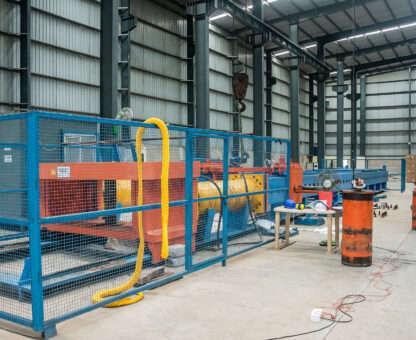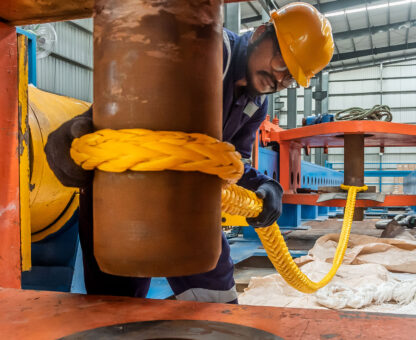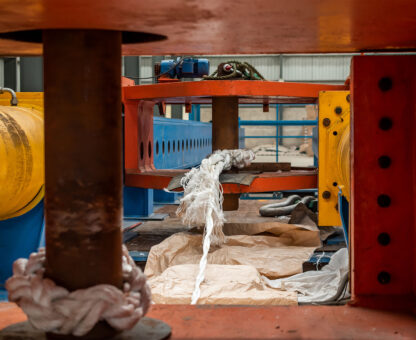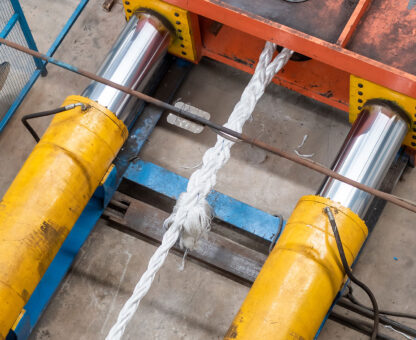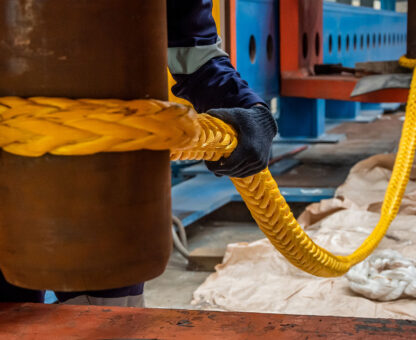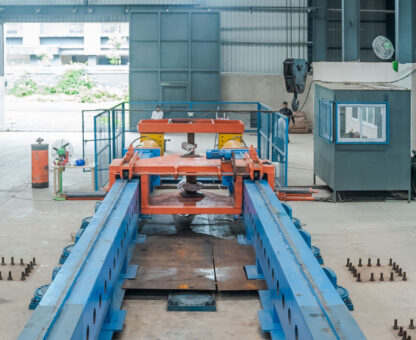Pioneering Load Testing with 1200T testing facility
State of the art facility for all Proof and Break Load Testing
Krishdhan Fabtech Pvt Ltd takes pride in offering a state-of-the-art facility in Rasayani, Maharashtra, where we provide comprehensive proof and break load testing for a wide range of lifting appliances and rigging gears. Our facility is equipped with the latest technology and is operated by experienced professionals to ensure that every product meets the highest safety and quality standards

PROOF LOAD/ BREAK LOAD TESTING

Description
Proof and Break Load Testing: Ensuring Safety and Reliability in Lifting Operations
In the realm of lifting operations, the safety and reliability of equipment are of paramount importance. Whether in construction, manufacturing, shipping, or any industry that involves heavy lifting, the integrity of lifting appliances and rigging gears directly impacts operational safety and efficiency. This is where Proof and Break Load Testing plays a crucial role. These testing methods are designed to rigorously assess the load-bearing capacity and durability of lifting equipment, ensuring that they perform as expected under real-world conditions.
Proof Load Testing
Proof Load Testing is a critical process used to validate the strength and structural integrity of lifting equipment. During this test, a load is applied to the equipment that is typically higher than the maximum operational load it will encounter in service, but within a safe margin. The goal is to ensure that the equipment can handle the specified load without any signs of permanent deformation or structural failure.
Key aspects of Proof Load Testing include:
Verification of Load Capacity: The primary objective of proof load testing is to confirm that the equipment can safely handle its rated load. By applying a controlled load, usually 1.25 to 1.5 times the maximum working load limit (WLL), the test verifies the equipment’s ability to operate under the intended conditions without compromising safety.
Detection of Defects: Proof load testing helps identify any manufacturing defects, material flaws, or weaknesses in the design. If the equipment shows any signs of permanent deformation, cracks, or other issues during the test, it indicates that the item may not be suitable for use.
Compliance with Standards: Proof load testing is often a mandatory requirement to comply with industry standards and regulations. It is an essential step in the certification process, ensuring that the equipment meets or exceeds the relevant safety guidelines.
Documentation and Traceability: Detailed records of proof load tests are maintained, providing traceability and documentation that the equipment has been tested and meets the required safety standards. This documentation is crucial for audits and inspections.
Break Load Testing
Break Load Testing, on the other hand, is designed to determine the maximum load at which a piece of equipment will fail. Unlike proof load testing, where the equipment is expected to survive the test without damage, break load testing pushes the equipment to its breaking point to assess its ultimate strength and failure mode.
Key aspects of Break Load Testing include:
Determination of Maximum Load Capacity: Break load testing identifies the absolute maximum load that the equipment can bear before failure. This information is crucial for understanding the safety margins and designing equipment with adequate strength for its intended application.
Understanding Failure Modes: By pushing the equipment to failure, break load testing reveals the specific points of weakness or the manner in which the equipment fails. This insight is valuable for improving design, material selection, and manufacturing processes to enhance safety and durability.
Safety Margins and Design Improvements: The results from break load testing help manufacturers establish safety margins, ensuring that the equipment is operated well within its failure limits. Additionally, the insights gained from this test can lead to design improvements that make the equipment safer and more reliable.
Compliance and Certification: Like proof load testing, break load testing is often required for compliance with industry standards, especially in critical applications where safety is non-negotiable. Certification based on break load test results assures customers that the equipment has been rigorously tested and meets the highest safety criteria.
Applications and Importance of Proof and Break Load Testing
Proof and break load testing are indispensable in various industries, including:
- Construction: Ensuring that cranes, hoists, and lifting slings can safely handle loads during construction projects.
- Manufacturing: Testing the load-bearing capacity of machinery and components used in production processes.
- Shipping and Logistics: Verifying the strength of lifting appliances used in loading and unloading cargo.
- Oil and Gas: Ensuring the safety of lifting equipment used in offshore and onshore drilling operations.
- Mining: Testing the durability of equipment used in harsh environments and under extreme conditions.
Application
Lifting/Spreader beam
Spreader beams are critical components in lifting operations, providing stability and distributing loads evenly across multiple lifting points. At Krishdhan Fabtech, we conduct rigorous proof load testing on spreader beams to verify their structural integrity and load-bearing capacity. Our testing process ensures that each beam can handle its rated load safely, minimizing the risk of failure during operations.
Chain blocks
Chain blocks are essential lifting devices used in various industries for lifting heavy loads with precision. We offer comprehensive testing for chain blocks to assess their durability, functionality, and load capacity. By subjecting these devices to proof and break load tests, we ensure that they perform reliably under demanding conditions, enhancing safety in the workplace.
Monorail Hoists
Monorail hoists are used in numerous industrial settings for lifting and transporting loads along a fixed path. Our testing facility is equipped to handle the proof and break load testing of monorail hoists, ensuring they meet stringent safety standards. We evaluate their performance under various load conditions, verifying that they operate smoothly and safely throughout their service life.
Chains/Chain slings
Chain slings are widely used in lifting operations due to their strength and versatility. We conduct detailed testing on chain slings to confirm their load capacity and resistance to wear and tear. Our testing procedures include proof load tests and break load tests to certify that each chain sling can handle the specified loads without compromising safety.
Wire ropes/Wire Rope Slings
Wire ropes and wire rope slings are crucial for lifting heavy loads in construction, shipping, and other industries. At Krishdhan Fabtech, we perform extensive testing on wire ropes and slings to ensure they meet the required safety standards. Our tests verify the tensile strength, flexibility, and durability of these components, ensuring they can withstand the stresses of heavy lifting operations.
Polyester Slings
Polyester slings are preferred for their lightweight and non-abrasive properties, making them ideal for lifting delicate or sensitive loads. Our facility offers proof and break load testing for polyester slings, confirming their strength and reliability. We ensure that each sling is capable of handling its rated load without stretching or failing, providing peace of mind for users.
FAQs
1. What is the purpose of Proof Load Testing?
Proof Load Testing is conducted to verify that a piece of lifting equipment or rigging gear can safely handle its rated load without any signs of structural damage or permanent deformation. This test is crucial for ensuring the equipment’s reliability and compliance with safety standards.
2. How is Proof Load Testing performed?
During Proof Load Testing, a load that is typically 1.25 to 1.5 times the equipment’s maximum working load limit (WLL) is applied. The equipment is then inspected for any signs of damage or deformation. If it passes the test without issues, it is deemed safe for operational use.
3. What is the difference between Proof Load Testing and Break Load Testing?
Proof Load Testing checks whether equipment can handle a specified load without damage, ensuring it is safe for regular use. Break Load Testing, on the other hand, pushes the equipment to its failure point to determine the maximum load it can bear before breaking. Break Load Testing helps understand the equipment's ultimate strength and failure modes.
4. Why is Break Load Testing important?
Break Load Testing is essential for identifying the absolute load capacity of equipment and understanding how and where it may fail. This information is vital for designing safer equipment, establishing safety margins, and ensuring that equipment is used well within its limits.
6. What types of equipment are typically tested using Proof and Break Load Testing?
Proof and Break Load Testing are commonly applied to a wide range of lifting appliances and rigging gear, including spreader beams, chain blocks, monorail hoists, chain slings, wire ropes, wire rope slings, and polyester slings.
7. How often should lifting equipment undergo Proof Load Testing?
The frequency of Proof Load Testing depends on industry regulations, the equipment’s usage, and the manufacturer’s recommendations. It is typically conducted during initial certification, after significant repairs or modifications, and at regular intervals as part of routine maintenance.
Have a Project? Let’s Talk!
TESTING FACILITY
